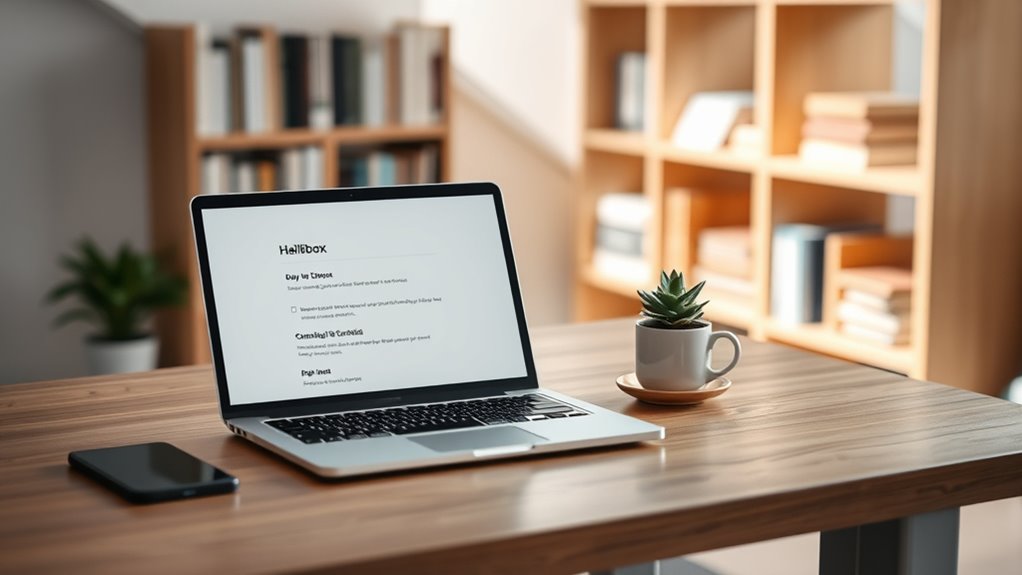To write a mindful email, focus on clarity and purpose while keeping it brief. Stick to essential details, use simple language, and avoid unnecessary information. Keep your tone friendly, professional, or assertive as needed, and review your message to guarantee it’s balanced. When you craft your email with these tips, you’ll communicate more effectively and build better relationships. Continue exploring these strategies to master the art of concise, impactful messaging.
Key Takeaways
- Focus on the main purpose, eliminating unnecessary details for clarity.
- Use short, direct sentences to communicate efficiently and avoid ambiguity.
- Read emails aloud to gauge tone and ensure professionalism or friendliness as needed.
- Tailor language and tone based on the recipient’s relationship for appropriate impact.
- Review and edit messages to maintain brevity while including essential information.

In today’s fast-paced digital world, it’s easy to fall into the trap of sending quick, impulsive emails that can lead to misunderstandings or unnecessary stress. The key to avoiding that pitfall lies in mastering email brevity and tone calibration. When you focus on writing less and saying more, your messages become clearer, and your relationships with colleagues or clients improve. The goal isn’t to cut corners but to communicate efficiently without sacrificing meaning or professionalism.
Start by asking yourself what the core purpose of your email is. Is it to inform, request, or clarify? Once you identify that, craft your message around it. Keep sentences short and direct. Instead of lengthy explanations, use precise language that gets straight to the point. This approach not only respects the recipient’s time but also reduces the chance of misinterpretation. Remember, the more concise your email, the easier it is for others to understand your intent and respond appropriately.
Identify your email’s purpose and craft concise, direct messages to respect time and ensure clarity.
Tone calibration is equally important. The way your message is perceived depends heavily on how you phrase it. Before hitting send, read your email out loud or take a moment to consider how it might sound to someone else. Is your tone friendly, professional, or assertive enough? Avoid ambiguous language that can be misread as harsh or indifferent. Adding polite phrases like “please” or “thank you” can soften your tone, making your message more approachable. Be mindful of your word choice—words like “urgent” or “immediately” can come off as demanding if not justified, so use them sparingly.
Another effective tactic is to tailor your language based on your relationship with the recipient. For colleagues you work closely with, a slightly informal tone might be appropriate, but always maintain professionalism. For external contacts, stick to formal language, but still aim for warmth and clarity. Adjusting your tone ensures your message resonates well and fosters positive interactions.
Finally, always review your email before sending. Check if it’s as brief as it can be without losing essential details and whether the tone matches the context. A well-calibrated tone combined with brevity makes your emails more impactful. When you practice this mindful approach, you’ll find fewer emails require follow-ups, less confusion arises, and your communication becomes more effective. Writing less, but saying more, helps you build trust and efficiency in your digital communication. Incorporating effective email marketing strategies can further enhance your outreach by ensuring your messages are both concise and targeted.
Frequently Asked Questions
How Can I Measure the Effectiveness of Mindful Emailing?
You can measure the effectiveness of mindful emailing by observing changes in your email tone and message clarity. Ask recipients for feedback, noting if responses are quicker or more positive. Track if your emails lead to fewer misunderstandings or follow-up questions. Additionally, monitor if your concise, thoughtful messages foster better collaboration. These indicators help you see if your mindful approach improves communication, making your emails more impactful and efficient.
What Tools Support Mindful Email Practices?
Think of tools supporting mindful email practices as your inbox’s GPS, guiding you with clarity and purpose. Apps like Boomerang, Spark, and SaneBox help you master email etiquette and inbox management, reducing clutter and promoting thoughtful responses. They remind you to pause before hitting send, ensuring your message is clear and considerate. These tools turn your inbox into a well-organized space, helping you communicate effectively without overwhelm.
How Do I Handle Urgent Emails Mindfully?
When handling urgent emails, stay calm and set a mindful email tone by acknowledging the message promptly without rushing your response. Focus on clarity and brevity, avoiding unnecessary details. Prioritize your response time, but don’t sacrifice thoughtfulness for speed. Take a moment to breathe if needed, ensuring your reply is respectful and effective. This approach helps you manage urgency mindfully while maintaining professional communication.
Can Mindful Email Habits Improve Team Communication?
Like a skilled conductor guiding an orchestra, mindful email habits can harmonize team communication. By focusing on a respectful email tone and crafting message clarity, you foster understanding and reduce misinterpretations. This approach encourages openness, minimizes conflicts, and boosts collaboration. When everyone practices mindful emailing, your team becomes more synchronized, ensuring that every message hits the right note and drives projects forward smoothly and efficiently.
How Do Cultural Differences Affect Mindful Email Writing?
Cultural differences substantially influence mindful email writing by shaping your approach to cultural communication and language nuances. You might need to adapt your tone, formality, and directness to respect cultural norms, avoiding misunderstandings. By being aware of these differences, you guarantee your messages remain clear and respectful, fostering better collaboration. Pay attention to cultural cues, and adjust your email style accordingly to promote effective, mindful communication across diverse teams.
Conclusion
Remember, less truly is more. When you craft your emails mindfully, you turn each message into a clear, potent tool—like a well-placed spark that ignites understanding. By saying less, you invite your reader to hear what truly matters, turning ordinary words into extraordinary connections. So, next time you write, channel your inner poet and let your words dance—because in simplicity, your message shines brightest, leaving a lasting impact like a gentle whisper that echoes forever.









